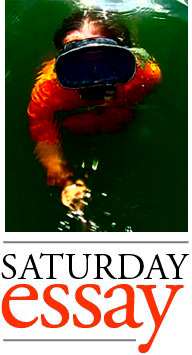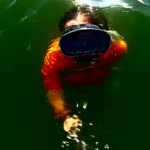Victims of the Wreck of the Wilson Should Have a Memorial
 A recent push to place a memorial to the Edmund Fitzgerald on Barker’s Island got me thinking about the local oft-forgotten wreck of the Thomas Wilson. My 1995 edition of the book Shipwrecks of Lake Superior (edited by James R. Marshall) calls the Wilson “Duluth’s doorstep shipwreck.” The author of the Wilson chapter is legendary local scuba diver Paul von Goertz, who says on page 75 that “The Thomas Wilson ‘sails the bottom’ less than a mile from the ship canal.” A 308-foot whaleback steamer loaded with ore, the Wilson got T-boned in 1902 and sank within three minutes.
A recent push to place a memorial to the Edmund Fitzgerald on Barker’s Island got me thinking about the local oft-forgotten wreck of the Thomas Wilson. My 1995 edition of the book Shipwrecks of Lake Superior (edited by James R. Marshall) calls the Wilson “Duluth’s doorstep shipwreck.” The author of the Wilson chapter is legendary local scuba diver Paul von Goertz, who says on page 75 that “The Thomas Wilson ‘sails the bottom’ less than a mile from the ship canal.” A 308-foot whaleback steamer loaded with ore, the Wilson got T-boned in 1902 and sank within three minutes.
What bothers me about the wreck is that it may hold the remains of seven crew members:
“Of the 20 men that comprised the Wilson’s crew, nine were lost. Only two of the nine bodies were recovered. The remaining seven are entombed to this day in the hull of the Wilson … [the wreck] remains in pretty good shape …. To the best of my knowledge, entry has not been gained into the turret housing the boiler room. A safe guess would be that the men entombed in the wreck might be found in the boiler room, as this was the compartment nearest the actual point of collision. The preservation qualities of ice cold Lake Superior have protected the old wreck well … On one dive, I examined some wooden planking near the stern. The wood was not in the least rotted and even the putty in the seams was intact … One could safely speculate that the cold water would also preserve the remains of the seven sailors entombed in her belly.” (Lake Superior Shipwrecks, pp. 76-77)
The anchor of the Wilson is on display by the Lift Bridge, and the accompanying plaque mentions the wreck, but it does not mention the human beings who died. That seems to me to be an error.
When you’re at Sir Ben’s and there’s a ship at anchor on the water out there, or a cluster of ships — they are close to the wreck, perhaps right over it. Roughly speaking, it lies just off intersecting lines drawn from Eighth Avenue East and the canal. It’s only 70 feet deep there, not some unfathomable depth. Ships coming and going pass overhead but not by much. Anchors have been dragged through the wreck over the years, ripping its hold open. A lifelong Duluthian swore to me the Wilson has occasionally bobbed up during rough weather; I have not seen that documented elsewhere so take it with a grain of salt, but neither can I dispute it.
The crew of the Fitzgerald lies out of sight far across the lake in 500 feet of water, but the memory and loss are still close to home. Meanwhile the crew of the Wilson may very well lie much closer, right out there in the shipping lanes, practically in town, all but forgotten in their cold water crypt. Bodies in such environments become coated with a pale waxy layer as fat migrates to the surface of the skin. It is a natural part of the preservative qualities of a cold water burial. Once I realized this I had a hard time not thinking about it.
Recently however I read the National Museum of the Great Lakes article about the sinking which contradicts some of the details given in the Shipwrecks of Lake Superior. The NMGL makes it sound more like the victims are not entombed on board, but were simply pulled under by the suction vortex of the sinking ship, and then lost to the lake. In addition they say no bodies were recovered, but Shipwrecks of Lake Superior says two bodies were recovered. Between these differing sources, I can’t tell how many people may rest in the Wilson.
The Wilson’s boiler exploded as it sank, which is what happens when a hot boiler plunges into freezing water. Boiler explosions are powerful; the NMGL article describes a man on deck being thrown “some distance from the hull” when it blew. Any crew in the boiler room may have been blown to smithereens. The NMGL says divers in 1902 “examin(ed) the sunken hull” and found no bodies, but that doesn’t necessarily mean they ventured inside the wreck, which is a whole other skill set.
But ultimately we know nine people died. They’ve been dead for 122 years and if von Goertz is correct, we should assume seven of them are still down there, whole or in pieces. The Wilson’s dead at least deserve the dignity of a plaque.
We know their names. Perhaps back in the day there were memorial services and the city considers the matter closed. But it seems strange that we publicly document the ship with a Lakewalk plaque, but not the souls who died there.
The crew members of the Wilson gambled their lives by working in what used to be a risky industry, and they lost. Perhaps some had few economic choices as they forged their destiny. The collision that killed them was not the fault of anyone on board. They were doomed even as they played their parts in the creation of the world of modern shipping we inhabit today. The wreck directly resulted in safer regulation, saving others from the same fate.
It’s not just a local shipwreck of idle interest with an anchor for evidence. It’s a human tragedy. It makes me think about the forgotten, unknown except among the community of shipwreck nerds. It doesn’t seem right. The names of the dead should be put on a plaque with funds donated by civic-minded local billionaires. Either the plaque by the canal could be updated, or a new marker could be installed on the Lakewalk somewhere near the base of Eighth Avenue East, which looks over the site. These dead should be remembered. Memorialize the crews of both the Fitzgerald and the Wilson.
An index of Jim Richardson’s essays may be found here.
Recommended Links:
Leave a Comment
Only registered members can post a comment , Login / Register Here














No Comments